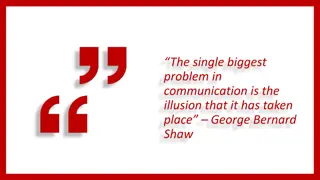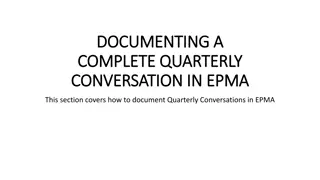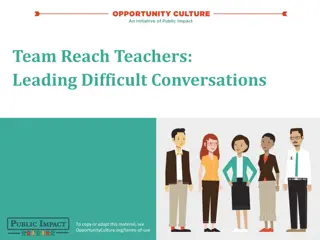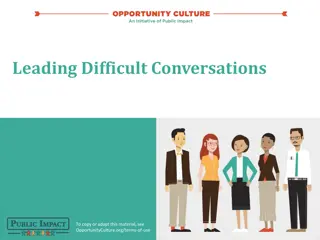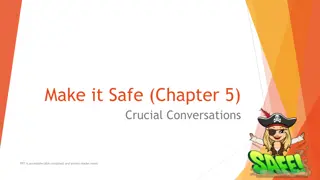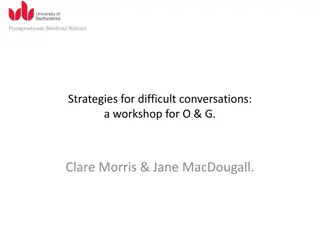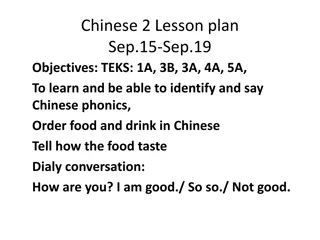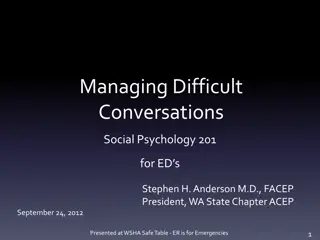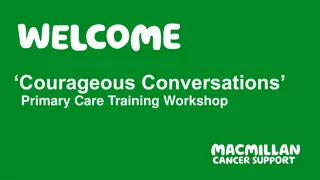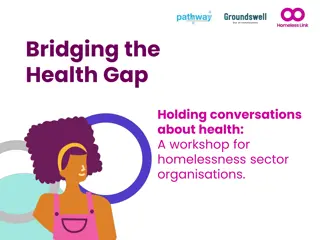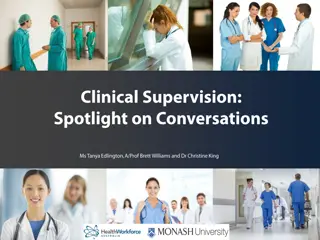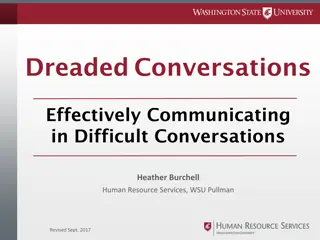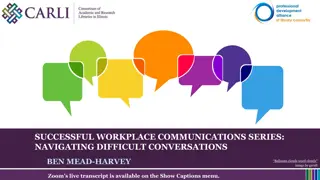Mastering Difficult Conversations in Healthcare: Strategies and Insights
Learn how to navigate challenging patient interactions effectively in healthcare settings through the lens of Conversations as Medicine. Discover key insights and strategies shared by Laura Heesacker, LCSW, to enhance confidence in managing difficult situations and promote patient well-being. Reflect on common traps and communication pitfalls while exploring ways to turn challenging conversations into opportunities for healing and understanding.
- Difficult Conversations
- Healthcare Communication
- Patient Management
- Conflict Resolution
- Empathy Skills
Download Presentation

Please find below an Image/Link to download the presentation.
The content on the website is provided AS IS for your information and personal use only. It may not be sold, licensed, or shared on other websites without obtaining consent from the author. Download presentation by click this link. If you encounter any issues during the download, it is possible that the publisher has removed the file from their server.
E N D
Presentation Transcript
Continuing Medical Education of Southern Oregon Conversations as Medicine (AKA Difficult Conversations) INTRO Laura Heesacker, LCSW May 20th, 2016
I have nothing to declare in regards conflicts of interest We all are rapidly using up our supply of pens and cups
Lauras 3 Truths 1. It is human nature to want to avoid things that are difficult 2. When it comes to prescription opioids for chronic non-cancer pain, we can t afford to avoid it anymore 3. It is possible to turn a difficult conversation into medicine
Clinicians: I am concerned about you and your medical conditions, both for your pain control but also for your safety. Oxycodone is no longer a good choice for either.
When a person s survival skills are so fine tuned it feels like manipulation Reframe
Does it ever feel like you have stepped into a trap?
Patient: Do you want me to suffer? Is that what you want? (Compassion Trap)
Youre cutting me off and I have to live with my pain? (All or Nothing Trap)
Are you accusing me of being an addict? Addiction Labeling Trap
Dont bother with any other meds, I ll just kill myself. Desperate/Threatening Trap
General Objectives 1) Increased confidence in managing patients in challenging situations 2) Increased understanding that having The Difficult Conversation will lead to both patient and provider enhanced satisfaction. 3) Increased awareness of patient s issues and agendas 4) Increased ability to engage the patient in a plan that will have a measurably improved functional outcome
Difficult Conversations Cycles Learning Objectives (15 Min) Patient/Provider Demo All Group Process (10 Min.) (poor) (10 Min.) Teamlette Breakout Practice All Group Process (10 Min.) (10 min.)
DIFFICULT DISCUSSIONS WITH PATIENTS: How to Have a Positive Outcome Lee S. Glass, MD Associate Medical Director Department of Labor & Industries
Disclosure #1 I have no financial conflicts of interest to disclose No relationships with any company or organization, other than Washington State
Difficult Discussions Some of the most important moments in medicine involve communication Some of the most important communications are sometimes avoided Discomfort, or fear of discomfort, is often the cause of communication avoidance in medicine We are likely to be more successful as physicians if we can initiate difficult discussions in a manner that is comfortable and effective for all concerned
Definition Difficult Discussion : A conversation, That involves content that may generate a negative emotional response in or from one or more parties, but which, if not conducted, will have consequences that one or more parties considers unfortunate or undesirable.
Goals Understand the role that difficult discussions may play in the practice of medicine Understand some ways in which one can prepare for a difficult discussion Learn techniques that maximize the likelihood that a difficult discussion will have a mutually satisfactory outcome.
Disclosure #2 Nobody s perfect What follows are concepts Most of the concepts outlined below I learned through mistakes I made some mistakes more than once Odds are great that some days we won t do so well implementing the concepts Suggestion: Keep practicing!
Difficult Discussion Condition: Inexplicable swelling of the non- dominant hand, sharply demarcated at the level of the wrist. Followed early DIP then MCP amputations, 3rd digit, non-dominant hand Patient sought amputation at level of wrist Differential Diagnosis: CRPS vs. factitious disorder Options: Medical: continue workup Legal: litigate
Difficult Discussion Option selected: Hospitalize and treat Outcome: Treatment sabotaged Noted in the chart: appearance of a band-like constriction at the level of the wrist Patient s explanation: elastic cuff on jacket sleeve Physician s response: bilateral cuffs; unilateral swelling Final Diagnosis: CRPS
Difficult Discussion Outcome (2 years later): Per attorney: He hasn t killed himself yet Family is ruined He hasn t killed himself yet The kids have problems He hasn t killed himself yet
Difficult Discussion Why this outcome: Doctors involved were not trained in having difficult discussions with patients Hospital professional staff not trained in having difficult discussions (with doctors or patients) The system allowed all involved to ignore the diagnosis of factitious disorder made by pain clinic psychologist
Difficult Discussions What are they? Necessary verbal communications that are, or are anticipated to be Uncomfortable or difficult for one or more participants Settings anywhere Exam room Home Work Etc.
When They Dont Happen Opportunities are missed Relationships suffer Professional Collegial Familial Supervisory
Why They Dont Happen Discomfort: One or more potential participants fear discomfort: Anger Loss Revenge Physical Economic Embarrassment Etc.
How We Avoid Them Denial There is no problem Not my job Avoidance Don t return phone calls or letters Body English (e.g. stand in doorway) Intimidation Demeanor Content of speech
Why They Dont Happen There s no problem:: One or more potential participants are blinded as to the need for a discussion Pain doctor prescribing 120 mg of morphine/day for back pain not precipitated by an injury Patient (28 y.o. F) lost custody of 8 y.o. son 2 yrs before; on opioids last 1.5 years. When doctor was asked why father has custody, he answered: Mother had a drug abuse problem.
Why They Dont Happen One or more potential participants view difficult discussions as not my job Surgeon: will not delve into patient s prior history of sexual abuse Surgeon: not my job to arrange for psychological treatment for severely depressed surgical candidate Pain doctor will not call primary care physician regarding psychological issues
Difficult Discussions: Goals Build, strengthen, or repair a relationship Professional Family Supervisory Strategic Achieve health care goal e.g. assent for substance abuse treatment e.g. discuss spousal abuse issues Etc.
Difficult Discussions: Goals Relationship is strengthened or advanced Strategic goal is achieved or agreeably modified Feel good when the discussion is over You feel good Others feel good
Difficult Discussions: Preparation What is the best time to prepare for the next difficult discussion? Now Why now ? Because there may be a lot to do Because nobody knows when the next difficult discussion will arise
Difficult Discussions: Preparation Major categories of preparation: Self Expectations Logistics
Difficult Discussions: Preparation Self The most important, by far The only part of the process over which any of us have complete control The part of the process most likely to produce or not produce! comfort
Difficult Discussions: Preparation Self Who am I? Honesty with self and others Trust of self and others Commitment What kind? How much? For how long? Comfort How comfortable are you? With yourself? With your patients? With their problems?
Difficult Discussions: Preparation Self Upon what foundation will you build the discussion? Scientific / professional Knowledge Training Skill Experience Personal Communication skills Value / belief system Resources (e.g. available time, etc.)
Difficult Discussions: Preparation Self Strategic analysis First have to have a clear understanding of goals: Question: What am I really trying to achieve? Flows from goals Question: What is the best strategy to achieve my goals?
Difficult Discussions: Preparation Patient Start relationship on firm foundation Only if it meets both parties needs will it last Patient s needs may not be fully understood initially Patient s needs may change over time Expectation setting First visit, whenever possible Clear, unambiguous Tied to the patient s best interests Consequences of unmet expectations are clear to patient
THE TAKE-HOME MESSAGE If an industrial injury is involved, the most important expectation is the role of the physician Physician is patient advocate Advocates for care that is necessary to treat the effects of the industrial injury or occupational disease What the patient needs and what the patient wants may differ Doctors advocate for medical needs Lawyers advocate for patient wants
Difficult Discussions: Preparation Logistics Time End of day versus during normal clinic day? 45 minutes versus 6 minutes? Place Exam room? Office or conference room? Teleconference? Participants Patient only? Others: Spouse? Employer? Etc.
Process Principal Considerations Trust Comfort Clarity Issue identification
Trust Cornerstone of the relationship Should be a two-way street But patient MUST be able to trust the doctor Should be established as quickly as possible I tell injured workers: There are only four rules to which I have never found an exception, and the first is that patients never look like their medical records suggest. Care should be taken to avoid ambiguities that might detract from trust
Process Comfort Critical Foundation for relationship Maximizes chances for effective communication Maximizes chances for maintaining a healthy physician/patient relationship Minimizes risk of harm To physician by patient (e.g. litigation, negative publicity) To patient by physician (e.g. damage to therapeutic relationship)
Process Comfort Contributors Setting Respectful of patient? (e.g. exam room versus office) Physically comfortable? (e.g. chair versus exam table) Interruptions versus quietude Support for patient (e.g. spouse or other advisor present?)
Process Comfort Contributors Timing Of the discussion Beginning or middle of day? Last appointment of day? In relationship to the issue A single event at issue? An established pattern at issue? Something in between?
Process Comfort Contributors Mood Patient s mood Your mood
Process Comfort Contributors Your attitude Is it what you want it to be? Is it likely to be clear to the patient? Difference between spoken words and body English? Will you be perceived as truthful and fair? Will you be perceived as trying to build a good relationship? What tone are you communicating?
Process Comfort Contributors Advanced notice Can help reduce fear Can set stage for a win-win discussion Allows both patient and physician to prepare for discussion To the alcoholic patient: Let s schedule you to come back in a week to take out the stitches. Let s also plan to talk about why you fell. I promise you that you ll feel a lot better after we talk than you felt after your fall.
Process Clarity The basis of effective communication Often perceived as present when actually absent What you thought you heard me say is not what I had intended to communicate. Three critical elements: Words that were spoken Words that were heard Meaning that was given by patient to words that were heard




